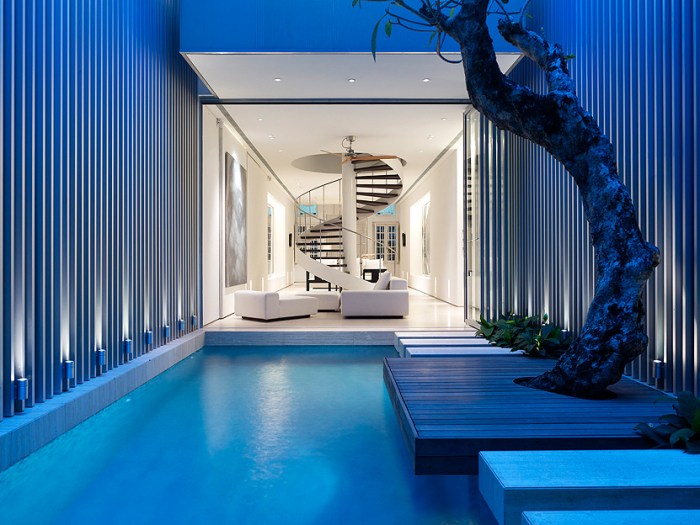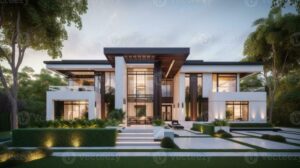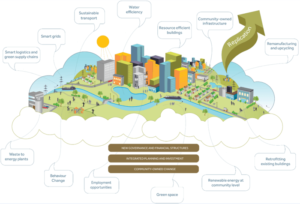
Beginning with Minimalist house design trends, this narrative unfolds in a compelling and distinctive manner, drawing readers into a story that promises to be both engaging and uniquely memorable.
Minimalism is taking the design world by storm, showcasing simplicity and functionality as the core tenets of contemporary living. The current trends emphasize clean lines, open spaces, and a thoughtful color palette that blends with natural materials, making homes not just aesthetically pleasing but also highly livable. As we explore these trends, we’ll see how they shape not only the physical structure of homes but also influence the lifestyle of those who inhabit them.
Current Minimalist House Design Trends
Minimalist house designs are currently shaping the architectural landscape, emphasizing simplicity, functionality, and a connection to the surrounding environment. The focus is on creating spaces that are uncluttered and serene, allowing for a more intentional lifestyle. This trend is not just about aesthetics; it reflects a broader cultural shift towards sustainable living and mindfulness.Key features of minimalist house designs trending in the market include open spaces, natural light, and a reduction in visual noise.
These elements combine to create a harmonious living environment that promotes clarity and tranquility. Minimalism is also characterized by its emphasis on materials and colors that evoke calmness and simplicity.
Popular Materials and Colors in Minimalist Designs
The choice of materials and colors plays a pivotal role in enhancing the minimalist aesthetic. Natural materials such as wood, stone, and metal are favored for their organic textures and durability. These materials not only contribute to the visual appeal but also promote sustainability.An important aspect of color selection in minimalist design is the use of a neutral palette that fosters a sense of calm.
Shades such as white, beige, gray, and soft pastels are commonly utilized. These colors create a clean backdrop that allows for the integration of art or other decorative elements without overwhelming the senses.
- Wood: Used for flooring, cabinetry, and furniture, wood adds warmth and a natural element to minimalist spaces.
- Concrete: Popular for its industrial look, concrete provides a sturdy and sleek finish for walls and surfaces.
- Glass: Large glass panels and windows are a hallmark of minimalist design, allowing natural light to flood the interior and blurring the line between indoors and outdoors.
- Metal: Accents of stainless steel or aluminum in fixtures and furniture add a modern touch while maintaining a simple aesthetic.
Contribution of Open Floor Plans to Minimalist Aesthetics
Open floor plans are a defining characteristic of minimalist house designs, promoting fluidity and ease of movement within spaces. By eliminating unnecessary walls and barriers, these layouts foster a sense of freedom and connection between different areas of the home. This design approach serves several purposes: it maximizes natural light, enhances sightlines, and creates an inviting atmosphere that encourages social interaction.
Open spaces can also be easily adjusted to accommodate varying activities, from cozy family gatherings to larger social events.
“The essence of minimalist design lies in creating harmonious spaces that foster well-being and mindfulness.”
In contemporary homes, open floor plans often integrate living, dining, and kitchen areas into one seamless space. This not only enhances the functionality of the home but also aligns with the minimalist philosophy of simplicity and efficiency. By keeping furniture and decor to a minimum, the focus shifts to the spatial experience and the relationships between different zones of the home.
Impact of Minimalist Design on Lifestyle

Minimalist design transcends mere aesthetics; it influences daily living in profound ways. Embracing a minimalist approach can lead to a more focused, serene environment that prioritizes essential elements, promoting well-being and mindfulness in our fast-paced lives. This approach not only simplifies physical spaces but also cultivates a lifestyle that values quality over quantity.Minimalist design significantly impacts personal well-being by creating environments that reduce stress and enhance comfort.
By eliminating clutter and unnecessary distractions, individuals can experience a greater sense of tranquility. A minimalist home often features open spaces, natural light, and a soothing color palette, all of which contribute to a calming atmosphere. These elements encourage relaxation and mental clarity, allowing residents to unwind and recharge more effectively after a busy day.
Relationship with Environmental Sustainability
Minimalist house designs are closely linked to environmental sustainability. By focusing on fewer, high-quality materials and energy-efficient solutions, these designs contribute to a reduced ecological footprint. The impact on sustainability can be understood through several key aspects:
- Reduced Waste: Minimalist designs emphasize the importance of quality over quantity, leading to less waste generated during construction and throughout the lifecycle of the home.
- Energy Efficiency: Many minimalist homes are designed with energy-efficient features, such as large windows for natural light, high-quality insulation, and sustainable building materials, which lower energy consumption.
- Smaller Footprints: A minimalistic approach often results in smaller living spaces, which typically require fewer resources to build and maintain, promoting a sustainable lifestyle.
- Durability: By investing in timeless, durable materials, minimalist designs minimize the need for frequent replacements, thereby reducing resource depletion.
Enhancement of Productivity and Creativity
Minimalist spaces can profoundly enhance productivity and creativity, particularly in work environments. By eliminating distractions and fostering an organized atmosphere, these designs empower individuals to focus on their tasks more effectively. The connection between minimalist design and increased productivity can be explained through several factors:
- Clarity of Purpose: A minimalist environment encourages clarity by limiting visual distractions, allowing individuals to immerse themselves in their work.
- Enhanced Focus: With fewer items competing for attention, individuals can concentrate better on tasks, resulting in improved outcomes and efficiency.
- Inspiration through Simplicity: The simplicity of minimalist design can stimulate creativity. Open spaces and uncluttered surfaces can inspire new ideas and innovative thinking.
- Encouragement of Mindfulness: Minimalist spaces promote mindfulness, helping individuals to remain present and engaged, which is essential for both personal and professional growth.
“Less is more” embodies the essence of minimalist design, promoting a lifestyle that values simplicity, sustainability, and focus.
Integrating Branding with Minimalist Design

In today’s fast-paced market, brands are continually seeking innovative ways to stand out. Embracing minimalist design principles can be a powerful strategy for businesses looking to enhance their brand identity. This approach not only streamlines visual aesthetics but also conveys messages more effectively, making it easier for consumers to connect with a brand’s core values.Minimalist design emphasizes simplicity, clarity, and functionality, making it an ideal choice for branding.
By reducing clutter and focusing on essential elements, brands can create a memorable identity that resonates with their audience. Here are some strategies for integrating minimalist design into branding efforts:
Strategies to Incorporate Minimalist Design Principles
Adopting minimalist design in branding requires a strategic approach. Here are effective methods to achieve this:
- Focus on Core Values: Identify and highlight the essential values of your brand. Use simple visuals and straightforward language to create a strong brand message that aligns with these values.
- Simplify Your Logo: A minimalist logo is easily recognizable and versatile across different platforms. Consider iconic designs that can be rendered in single colors or basic shapes for maximum impact.
- Limit Color Palettes: Utilize a restrained color palette to evoke emotions and maintain brand consistency. Neutral tones combined with one or two accent colors can effectively convey a minimalist aesthetic.
- Emphasize Negative Space: Leverage negative space in your designs to draw attention to key elements, allowing your brand identity to breathe and making it more visually appealing.
Using Minimalist Design in Advertising
Minimalist design can significantly enhance advertising by ensuring that messages are clear and impactful. Effective advertising through minimalism often includes:
- Clear Messaging: Use concise and straightforward language. The goal is to communicate the brand’s message without overwhelming the audience with information.
- Strong Visuals: Opt for bold images or graphics that relate directly to the message. A single, powerful image can often speak volumes more than a cluttered scene.
- Effective Call-to-Action: Design call-to-action buttons that are simple yet compelling. The wording should be direct, and the design should make it easy for consumers to understand the next steps.
- Consistent Branding: Maintain consistency in fonts, colors, and style across all advertising platforms to build brand recognition and trust with consumers.
Influence of Minimalist Aesthetics on Product Design and Packaging
Minimalist aesthetics extend beyond branding and advertising, significantly impacting product design and packaging. Brands that embrace minimalism tend to create products that reflect simplicity and functionality. Here’s how minimalism influences these areas:
- Functional Design: Minimalist products often prioritize usability and functionality over unnecessary features. This approach not only enhances user experience but also aligns with consumer preferences for straightforward solutions.
- Eco-Friendly Packaging: Brands are increasingly using minimalistic packaging that reduces waste. This can include simple, recyclable materials and designs that require less ink and resources.
- Timeless Appeal: Minimalist designs often transcend trends, resulting in products that remain relevant over time. This longevity can enhance brand loyalty and reduce the need for frequent redesigns.
- Enhanced Customer Experience: A clean and simple packaging design can improve the unboxing experience for customers, creating a lasting impression and fostering brand engagement.
Concluding Remarks
In conclusion, embracing Minimalist house design trends means adopting a lifestyle that prioritizes clarity, sustainability, and well-being. As we reflect on the key elements of minimalist design—from open floor plans to eco-friendly materials—we recognize its transformative power, not only in our homes but also in our daily lives. This approach encourages us to curate our spaces thoughtfully, ultimately leading to a more enriching and productive existence.
FAQ
What are the main benefits of minimalist house design?
Minimalist house design promotes simplicity, reduces clutter, and fosters a sense of tranquility while enhancing functionality and sustainability.
How can I start incorporating minimalist design into my home?
Begin by decluttering your space, choosing multifunctional furniture, and opting for a neutral color palette to create a calm environment.
Are minimalist designs suitable for small spaces?
Absolutely! Minimalist designs are perfect for small spaces as they maximize functionality and create an illusion of more space through open layouts.
What type of materials are best for minimalist homes?
Natural materials such as wood, stone, and metal are ideal for minimalist homes, as they add warmth and texture while remaining simple and elegant.
Can minimalist design be applied to outdoor spaces?
Yes, minimalist principles can enhance outdoor areas by incorporating clean lines, functional furniture, and a limited color palette, creating a serene environment.





